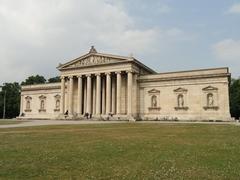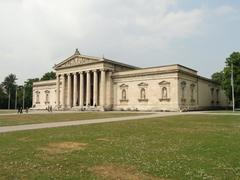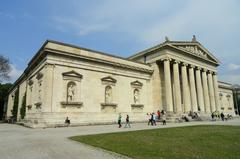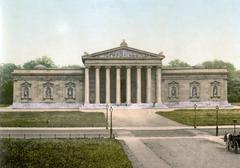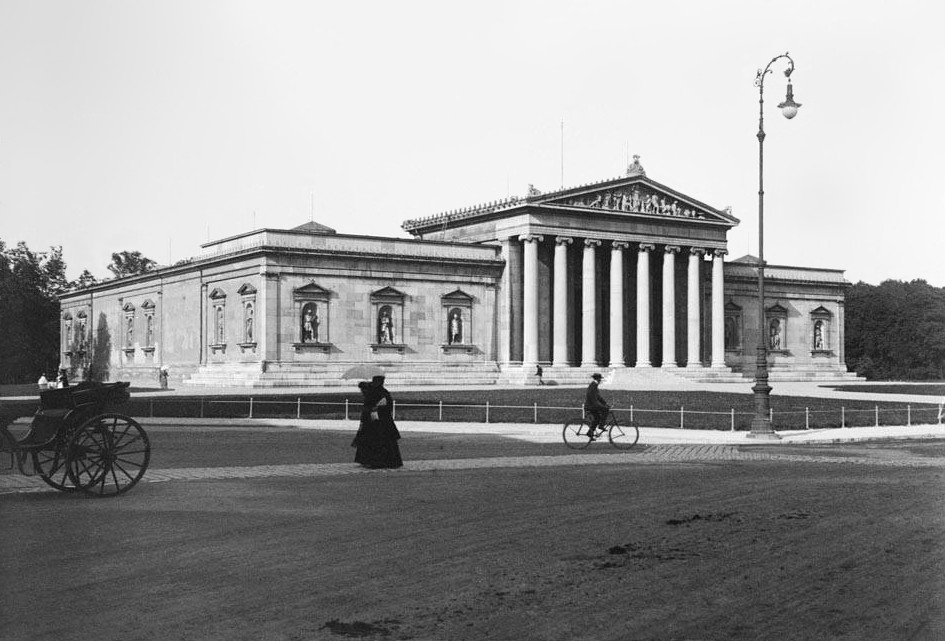
Visiting Glyptothek Munich Guide: Hours, Tickets, and Tips
Date: 23/07/2024
Introduction
The Glyptothek in Munich, Germany, stands as a testament to the timeless allure of classical antiquity, offering visitors a unique journey through the art and culture of ancient Greece and Rome. Founded by King Ludwig I of Bavaria in 1830, the Glyptothek is Munich’s oldest public museum, specifically dedicated to ancient sculpture (Bavarian State Collection of Antiquities). This neoclassical marvel, designed by the renowned architect Leo von Klenze, embodies the architectural and cultural aspirations of the Bavarian monarchy. The museum’s façade, adorned with grand Ionic columns and a triangular pediment, evokes the grandeur of ancient Greek temples, setting the stage for the treasures within. The Glyptothek’s extensive collection includes masterpieces such as the Barberini Faun, the Aegina Marbles, and the Munich Kouros, each offering invaluable insights into the artistic techniques and cultural practices of ancient civilizations (Munich Tourist Information). Over the years, the museum has undergone significant renovations, including post-World War II restorations, to preserve its architectural integrity and enhance the visitor experience (Munich Documentation Centre for the History of National Socialism). Today, the Glyptothek continues to serve as a vital cultural and educational institution, attracting scholars, students, and art enthusiasts from around the world.
Table of Contents
- Introduction
- Foundation and Early Years
- Architectural Design
- Collection Development
- World War II and Reconstruction
- Modern Era and Renovations
- Notable Exhibits and Artifacts
- Visitor Information
- Travel Tips
- Educational and Cultural Impact
- Visitor Experience
- Practical Visitor Information
- Impact on Modern Art and Culture
- Accessibility and Inclusivity
- Digital Presence and Virtual Tours
- Community Engagement and Outreach
- Future Prospects
- FAQ
- Conclusion
- Sources
Discover the Glyptothek - History, Visiting Hours, and Ticket Information
Foundation and Early Years
The Glyptothek in Munich, Germany, is a museum dedicated to ancient sculpture, primarily from Greek and Roman antiquity. It was commissioned by King Ludwig I of Bavaria and designed by architect Leo von Klenze. The museum’s construction began in 1816 and was completed in 1830. Ludwig I envisioned the Glyptothek as a cultural beacon, reflecting his admiration for classical antiquity and his desire to elevate Munich to a center of art and culture (Bavarian State Collection of Antiquities).
Architectural Design
Leo von Klenze’s design for the Glyptothek was heavily influenced by classical Greek and Roman architecture. The building features a neoclassical façade with Ionic columns and a triangular pediment, reminiscent of ancient temples. The interior is equally impressive, with a series of rooms arranged around a central courtyard, each designed to showcase different periods and styles of ancient sculpture (Munich Tourist Information).
Collection Development
The initial collection of the Glyptothek was assembled through acquisitions and donations, many of which were facilitated by Ludwig I’s extensive network of art dealers and collectors. Notable early acquisitions included the Barberini Faun, a Hellenistic sculpture dating to around 220 BCE, and the Aegina Marbles, a series of pedimental sculptures from the Temple of Aphaia on the Greek island of Aegina (Glyptothek Munich).
World War II and Reconstruction
The Glyptothek suffered significant damage during World War II, with much of the building being destroyed by Allied bombing raids. The museum’s collection was evacuated and stored in safe locations to protect it from the destruction. After the war, a lengthy reconstruction process began, led by architect Hans Döllgast. The museum was partially reopened in 1972, with full restoration completed by the late 1970s (Munich Documentation Centre for the History of National Socialism).
Modern Era and Renovations
In the decades following its post-war restoration, the Glyptothek has undergone several renovations to modernize its facilities and improve the visitor experience. One of the most significant recent renovations took place between 2018 and 2020, during which the museum was closed to the public. This renovation focused on updating the building’s climate control systems, improving accessibility, and enhancing the presentation of the collection (Bavarian State Collection of Antiquities).
Notable Exhibits and Artifacts
The Glyptothek’s collection includes some of the most important works of ancient sculpture in the world. Among the highlights are:
- The Barberini Faun: This Hellenistic sculpture, dating to around 220 BCE, depicts a sleeping satyr and is renowned for its dynamic pose and detailed anatomy (Glyptothek Munich).
- The Aegina Marbles: These sculptures, originally part of the Temple of Aphaia on the island of Aegina, date to around 500 BCE and are significant examples of early classical Greek art (Munich Tourist Information).
- The Munich Kouros: A marble statue of a young man, or kouros, dating to around 540 BCE, which exemplifies the early Greek sculptural style (Glyptothek Munich).
Visitor Information
Glyptothek Visiting Hours
The Glyptothek is open from Tuesday to Sunday, 10:00 AM to 5:00 PM. It is closed on Mondays and some public holidays. Visitors are encouraged to check the museum’s official website for any changes in visiting hours and special opening days.
Glyptothek Tickets
Ticket prices for the Glyptothek are as follows:
- General Admission: €6
- Reduced Admission: €4 (students, seniors, etc.)
- Free Admission: Children under 18, school groups, and certain other categories
Tickets can be purchased online in advance or at the museum’s ticket counter. Group tours and special exhibitions may require separate tickets.
Travel Tips
The Glyptothek is located on Königsplatz, a historic square in the heart of Munich. The museum is easily accessible via public transportation, with the Königsplatz U-Bahn station located nearby. Visitors can also reach the museum by bus or tram. Parking is available in the vicinity, but public transport is recommended due to limited parking space.
Nearby Attractions
While visiting the Glyptothek, consider exploring other nearby historical sites and attractions in Munich:
- Propylaea: A grand gateway modeled after the Propylaea in Athens, located on Königsplatz.
- Staatliche Antikensammlungen: The State Collections of Antiquities, located adjacent to the Glyptothek, showcasing a wide range of ancient artifacts.
- Alte Pinakothek: One of the oldest art galleries in the world, featuring European paintings from the 14th to the 18th centuries.
Accessibility
The Glyptothek is committed to providing an accessible experience for all visitors. The museum offers wheelchair access, and service animals are welcome. Accessible restrooms and elevators are available, and the staff is trained to assist visitors with disabilities. For specific accessibility needs, it is recommended to contact the museum in advance.
Educational and Cultural Impact
The Glyptothek has played a crucial role in the education and cultural enrichment of Munich and beyond. It serves as a resource for scholars and students of classical art and archaeology, offering a wealth of material for study and research. The museum also hosts a variety of educational programs, including lectures, workshops, and guided tours, aimed at engaging the public with the ancient world (Bavarian State Collection of Antiquities).
Visitor Experience
Guided Tours
The Glyptothek offers guided tours that provide in-depth insights into its collection and historical significance. Knowledgeable guides lead visitors through the museum, sharing fascinating stories and contextual information about the artworks.
Audio Guides
For those who prefer a self-guided experience, the Glyptothek provides audio guides that offer detailed descriptions and engaging narratives about the sculptures. These guides are available in multiple languages.
Interactive Exhibits
Interactive exhibits enhance the visitor experience by allowing guests to engage with the museum’s collection in a hands-on way. These exhibits provide additional context and make the art more accessible to a wider audience.
Practical Visitor Information
Visiting Hours
The Glyptothek is open from 10:00 AM to 5:00 PM from Tuesday to Sunday. The museum is closed on Mondays and public holidays. It’s advisable to check the official website for any changes in visiting hours.
Ticket Prices
General admission tickets are priced at €6.00, while reduced tickets for students and seniors are available at €4.00. Children under 18 can enter for free. Special exhibitions may have different pricing.
Travel Tips
The Glyptothek is conveniently located at Königsplatz in Munich, easily accessible by public transportation. Visitors can take the U2 subway line to Königsplatz Station or various bus routes that stop nearby.
Nearby Attractions
While visiting the Glyptothek, consider exploring other nearby historical sites and attractions in Munich:
- Kunstareal: A vibrant cultural district with several museums and galleries.
- Alte Pinakothek: Another renowned museum featuring an extensive collection of European paintings.
- Nymphenburg Palace: A stunning Baroque palace with beautiful gardens and interiors.
Impact on Modern Art and Culture
The Glyptothek’s influence extends beyond the realm of classical art. The museum has inspired numerous modern artists, architects, and designers who have drawn on its collection and architectural design for inspiration. The Glyptothek’s emphasis on the timeless beauty and universal themes of classical art resonates with contemporary audiences and continues to shape modern artistic and cultural discourse. The museum’s role as a cultural landmark in Munich also contributes to the city’s vibrant art scene and attracts visitors from around the world.
Accessibility and Inclusivity
The Glyptothek is committed to making its collection accessible to a diverse audience. The museum offers various accessibility services, including wheelchair access, tactile tours for visually impaired visitors, and educational programs tailored to different age groups and learning needs. The Glyptothek’s efforts to promote inclusivity and accessibility reflect its mission to provide a welcoming and enriching experience for all visitors, regardless of their background or abilities.
Digital Presence and Virtual Tours
In response to the growing demand for digital access to cultural institutions, the Glyptothek has developed a robust online presence. The museum’s website features high-resolution images of its collection, detailed descriptions of the artworks, and virtual tours that allow visitors to explore the museum from the comfort of their homes. The Glyptothek’s digital initiatives aim to reach a global audience and provide an alternative way to experience its collection, especially for those who cannot visit in person. These efforts highlight the museum’s commitment to leveraging technology to enhance accessibility and engagement with its collection.
Community Engagement and Outreach
The Glyptothek actively engages with the local community through various outreach programs and partnerships. The museum collaborates with schools, universities, and cultural organizations to promote art education and cultural exchange. The Glyptothek’s community engagement initiatives include workshops, lectures, and collaborative projects that foster a sense of shared cultural heritage and encourage active participation in the arts. By building strong connections with the community, the Glyptothek enhances its role as a cultural hub and contributes to the cultural vitality of Munich.
Future Prospects
Looking ahead, the Glyptothek aims to continue its mission of preserving and promoting classical art while adapting to the evolving needs of its audience. The museum plans to expand its educational programs, enhance its digital offerings, and undertake new restoration projects to ensure the long-term preservation of its collection. The Glyptothek’s future initiatives will focus on fostering greater accessibility, inclusivity, and engagement with its collection, ensuring that it remains a vital and dynamic cultural institution for generations to come.
Frequently Asked Questions (FAQ)
Q: What are the Glyptothek’s visiting hours?
A: The Glyptothek is open from 10:00 AM to 5:00 PM from Tuesday to Sunday. It is closed on Mondays and public holidays.
Q: How much do tickets to the Glyptothek cost?
A: General admission tickets are €6.00. Reduced tickets for students and seniors are €4.00. Children under 18 can enter for free.
Q: Are there guided tours available at the Glyptothek?
A: Yes, the Glyptothek offers guided tours that provide in-depth insights into its collection.
Q: Is the Glyptothek accessible for visitors with disabilities?
A: Yes, the Glyptothek offers various accessibility services, including wheelchair access and tactile tours for visually impaired visitors.
Q: Where is the Glyptothek located?
A: The Glyptothek is located at Königsplatz in Munich, easily accessible by public transportation.
For more information, visit the Glyptothek’s official website.
Visit and Stay Up to Date
Explore more about the Glyptothek and stay updated by following our social media channels and downloading the mobile app Audiala for the latest news and events. Check out other related posts on our website for more insights into Munich’s rich cultural heritage.
Conclusion
The Glyptothek remains a cornerstone of Munich’s rich cultural landscape, offering an unparalleled glimpse into the artistic achievements of ancient Greece and Rome. Through its meticulously curated collection and thoughtfully designed museum space, it continues to educate and inspire visitors, fostering a deep appreciation for classical art and history. The museum’s commitment to accessibility and inclusivity ensures that it remains a welcoming space for all, while its ongoing restoration and digital initiatives highlight its dedication to preserving cultural heritage for future generations. As you plan your visit to Munich, the Glyptothek stands out as a must-see destination, promising a captivating journey through time. Stay connected with the latest updates and events by following the Glyptothek on social media and downloading the mobile app Audiala. Don’t miss the opportunity to explore this historical gem and immerse yourself in the timeless beauty of ancient sculpture (Bavarian State Collection of Antiquities).
References
- Bavarian State Collection of Antiquities, 2024 https://www.antike-am-koenigsplatz.mwn.de/en/glyptothek.html
- Munich Tourist Information, 2024 https://www.munich.travel/en/pois/culture-sights/glyptothek
- Munich Documentation Centre for the History of National Socialism, 2024 https://www.ns-dokuzentrum-muenchen.de/en/

